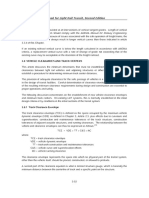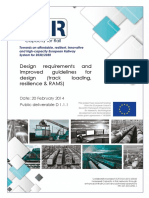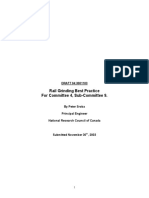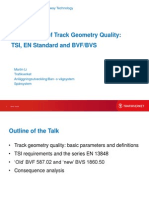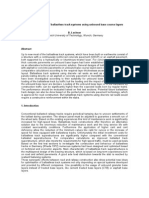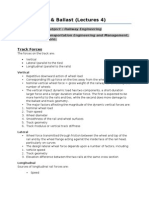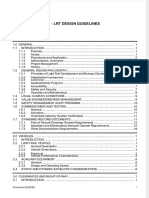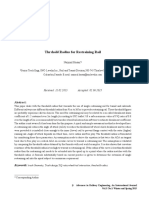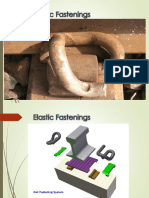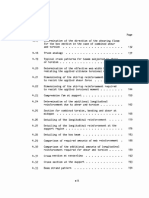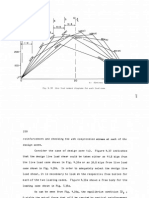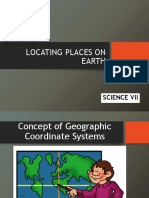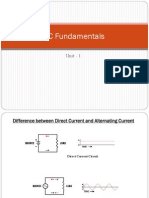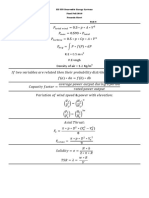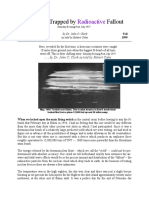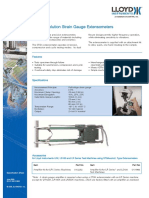Track Design Handbook TCRP - RPT - 155 2nd Ed. (2012) - Part21
Track Design Handbook TCRP - RPT - 155 2nd Ed. (2012) - Part21
Uploaded by
linghuchongCopyright:
Available Formats
Track Design Handbook TCRP - RPT - 155 2nd Ed. (2012) - Part21
Track Design Handbook TCRP - RPT - 155 2nd Ed. (2012) - Part21
Uploaded by
linghuchongOriginal Title
Copyright
Available Formats
Share this document
Did you find this document useful?
Is this content inappropriate?
Copyright:
Available Formats
Track Design Handbook TCRP - RPT - 155 2nd Ed. (2012) - Part21
Track Design Handbook TCRP - RPT - 155 2nd Ed. (2012) - Part21
Uploaded by
linghuchongCopyright:
Available Formats
Trac ck Design Handbook H for f Light Ra ail Transit, , Second Ed Edition
In slo ow-speed em mbedded track k in urban areas, where the need to conform to existing stree et profile es makes com mpliance with the above cr riteria impract ticable, the above requirem ment is usual lly waive ed. Where a tangent be etween vertic cal curves iis shorter th han 40 feet t [12 meters s], consid deration shou uld be given to t using reve erse or compo ound vertical curves. This s avoids abrupt chang ges in vertica al acceleratio on that could result in bot th passenger r discomfort and excessiv ve vehicl le suspension n system wea ar.
Figu ure 3.3.1 Ver rtical curve n nomenclature e
3-38
Light Rail Transit Track Geometry 3.3.2 Vertical Grades Maximum grades in track are controlled by vehicle braking and tractive capabilities. As explained in Chapter 2, the vehicle capabilities can vary depending on many factors. In addition, because the coefficient of friction between the rail and the wheel can vary depending on environmental conditions, the maximum grade can be affected by the presence of not only water, snow, and ice but also by vegetation, particularly wet and oily fallen leaves. Such rail surface contamination can be a significant issue in embedded track and grass track. On main line track, civil drainage provisions often dictate a minimum recommended profile grade. In yards, shops, and at station platforms, there is usually secondary or cross drainage available. Provided adequate drainage can be ensured, tracks that are level or nearly so can be acceptable in ballasted and direct fixation trackforms. See Chapter 4 for additional discussion of trackway drainage. Embedded tracks need to have some minimum gradient so that not only the pavement surface but also the flangeways will drain. Flangeways accumulate dirt and street debris that needs to be flushed away by storm water runoff. In colder climates, if the flangeways do not drain, there is a possibility of water and debris freezing in the flangeway and causing a derailment. A 2% track grade would be desirable, but may be impractical on many flat urban streets where existing adjoining development prevents any meaningful adjustments in pavement grades. 3.3.2.1 Main Tracks As a guideline, Table 3.3.1 provides recommended profile grade limitations for general use in LRT main track design. The desired maximums stated should be acceptable for all light rail vehicles. Some vehicles may be suitable for operation on somewhat steeper acceptable maximum gradients. Table 3.3.1 Maximum and minimum main track gradients Desired Maximum Unlimited Sustained Grade (any length) Desired Maximum Limited Sustained Grade (up to 2500 feet [750 meters] between points of vertical intersection (PVIs) of vertical curves) Desired Maximum Short Sustained Grade (no more than 500 feet [150 meters] between PVIs of vertical curves) Absolute Maximum Grade Unless Restricted by the Vehicle Design (acceptable length to be confirmed with vehicle designers) Acceptable Minimum Grade for Drainage on Embedded Track Acceptable Minimum Grade for Direct Fixation and Ballasted Trackforms (provided other measures are taken to ensure drainage of the trackway) 4.0% 6.0%
7.0% 9.0% 0.5%
0.0%
3-39
Track Design Handbook for Light Rail Transit, Second Edition
There are ample examples of grades in existing LRT lines that are both steeper and longer than the desired figures given in Table 3.3.1. For that reason alone, the gradients and lengths above are general guidelines and, within reason, should not be considered as inviolate. For example, there is no compelling reason why a 6.05% grade that is 2,567 feet in length should be automatically rejected. On the other hand, a 6.79% grade that is 3,215 feet in length should be scrutinized more closely, including coordination with the LRV engineers, before being accepted. Very long hills that incorporate multiple segments with gradients at or near the maximums should also be carefully coordinated with the vehicle engineers. For example, inserting a short segment of 2.0% grade between two segments of 6% grade, each of which individually meets the maximum length criteria, does not necessarily mean that the vehicle wont have issuesfor example, the thermal capacity of the friction braking system. Engineering judgment, guided by an interdisciplinary systems approach and considering project and site-specific information, should govern, not arbitrary guidelines such as the figures cited in Table 3.3.1. On any gradient, tractive forces at the wheel/rail interface (including braking) will always tend to push the rail downhill. Maintaining ballasted track horizontal alignment at the foot of a steep grade is sometimes very difficult, particularly if there is a coincident sharp horizontal curve at that location. Because of this maintenance issue, a rigid trackform (direct fixation or embedded) is preferred for steeply graded tracks. Track designers should consider rigid trackforms for grades steeper than 6%, particularly if combined with sharp curvature and/or frequent hard braking. 3.3.2.2 Pocket Tracks Where pocket tracks are provided for the reversal of revenue service trains, track grades should preferably not exceed the values stipulated below for yard running tracks. Flatter grades are preferred for pocket tracks since they are often used as temporary storage points for unattended maintenance-of-way equipment and disabled light rail vehicles. 3.3.2.3 Main Tracks at Stations and Stops See Article 3.5.2 for discussion concerning track gradients at station platforms. 3.3.2.4 Yard and Secondary Tracks Yard sites are generally preferred to be level so that unattended vehicles cannot roll away. Topography often makes this impractical. In addition, modern transit cars, unlike railroad freight equipment, typically have brakes that are applied by spring action and can only be released by pneumatic or hydraulic pressure. So, as a practical matter, there is little chance that an LRV, parked in ready-for-service condition, might ever roll away. The same cannot be said about vehicles that are either in the shop or stored outside awaiting repair, since their braking systems may be ineffective. Similarly, maintenance-of-way equipment could potentially roll away if parked without hand brakes set. Yards and shop facilities sometimes employ a small locomotive or car mover to shift out-of-service vehicles from one track to another. Maximum track grades in the yard should be such that the locomotives available tractive effort is more than sufficient to move an AW0 light rail vehicle. Table 3.3.2 provides guidelines that can be used for yard track gradients:
3-40
Light Rail Transit Track Geometry
Table 3.3.2 Maximum and minimum yard track gradients Yard Running Tracks Desired Acceptable Maximum Absolute Maximum 0.5% 1.0% Maximum grade for towing or pushing disabled LRVs with the yards shifting equipment Yard Storage Tracks Desired Acceptable Maximum 0.0% 0.2%
All tracks entering a yard should either be level, sloped downward away from the main line, or dished to prevent rail vehicles from rolling out of the yard onto the main line. For yard running tracks, a slight grade, usually about 0.5%, is recommended to achieve good track drainage at the subballast level. Through storage tracks generally have a sag in the middle of their profile to prevent rail vehicles from rolling to either end. Similarly, it is recommended that the profile grade of a stub end storage track descend toward the stub end and, if it is adjacent to a main line or secondary track, it should be horizontally curved away from that track at its stub end. If it is necessary for the profile grade of a storage track to slope up toward the stub end, the grade should not exceed 0.20%. Tracks located within maintenance shops and other buildings are generally level. However, so that storm water flows away from the building and not into the maintenance pits, it is customary for shop tracks to have a very slight upward slope (typically 0.5% or less) into the building up to the second column line of the building. This distance is typically about 20 to 25 feet [6 to 8 meters]. This gradient would continue across the apron driveway that typically runs around the shop building perimeter. 3.3.3 Vertical Curves All changes in grade are connected by vertical curves. Vertical curves are defined by parabolas having a constant rate of change in grade. Parabolic curves are, for all practical purposes, equivalent to circular curves for LRT design, but parabolic curves are easier to calculate and are thus preferable for this purpose. 3.3.3.1 Vertical Curve Lengths The minimum length of vertical curves can be determined as follows: Desired Minimum Length: Acceptable Minimum Length: LVC = 200A [LVC = 60A] LVC = 100A [LVC = 30A]
3-41
Track Design Handbook for Light Rail Transit, Second Edition
Absolute Minimum Length: Crest Curves:
LVC = AV 2 2 AV LVC = 215
2 AV LVC = 387
25
2
Sag Curves:
LVC = AV
45
where LVC = length of vertical curve in feet [meters] A = (G2 G1) algebraic difference in gradients connected by the vertical curve, in percent G1 = percent grade of approaching tangent G2 = percent grade of departing tangent V = design speed in mph [km/h] The numerical results from the formulas above are minimums. The designer should use longer vertical curves whenever possible. Both sag and crest vertical curves should have the maximum possible length, especially if approach and departure tangents are long. Vertical broken back curves and short horizontal curves at sags and crests should be avoided. 3.3.3.2 Vertical Curve Radius As noted in Chapter 2, vehicle manufacturers typically specify a products vertical capability in terms of either a radius or as a maximum angle that can be tolerated by the articulation joint. Since light rail vehicles are universally designed and built using S.I. dimensional units, these vertical radii are commonly specified in meters. Common figures stipulated by carbuilders (who universally use S.I. units of measurement) for high-floor LRVs for the minimum equivalent radius of curvature for vertical curves located in tangent track are 250 meters [820 feet] for crests and 350 meters [1150 feet] for sags. The track alignment designer must therefore evaluate whether a particular parabolic vertical curve meets the carbuilders criteria. This equivalent radius of curvature can be calculated from the following formula, which works in either U.S. traditional units or S.I. units:
Rv = where Rv =
LVC 0.01 (G2 G1)
minimum radius of curvature of a vertical curve in either feet or meters and LVC in the same units
Conversely, the following formula can be used to calculate the requisite vertical curve length given the vehicle manufacturers criteria for either crest or sag vertical curves. LVC = 0.01 (G2 G1) Rv
3-42
Light Rail Transit Track Geometry
3.3.3.3 Vertical Curves in the Overhead Contact System The profile of the contact wire cannot precisely mimic a vertical curve in the track. Instead it is a series of chords with a slight vertical angle at each suspension point with a smoothing of severe trolley grade changes through hanger modifications. Minimum vertical curve length and/or design speed may be governed by the overhead contact system (OCS) due to the maximum permissible rate of separation or convergence between the track grade and the contact wire gradient. Coordination with the OCS designer is strongly recommended to ensure compliance with these limitations. 3.3.4 Vertical CurvesSpecial Conditions 3.3.4.1 Reverse Vertical Curves Reverse vertical curves are feasible, provided each curve conforms to the requirements stated in Article 3.3.3 and the restrictions imposed by the LRT vehicle design. 3.3.4.2 Combined Vertical and Horizontal Curvature Where possible, areas of combined vertical and horizontal curvature should be avoided. Where this is not possible, the track geometry should be as gentle as possible, preferably with neither parameter at or close to a minimum. When extremely constrained site conditions dictate, combined curves should generally not be more severe than an 82-foot [25-meter] radius horizontal combined with a 820-foot [250-meter] equivalent radius vertical crest curve. These parameters must be conformed to the vehicle design specifications. 3.4 TRACK ALIGNMENT AT SPECIAL TRACKWORK
The track alignment must consider the requirements of the special trackwork layouts that will permit tracks to diverge, merge, and cross one another. Users of this Handbook should refer Chapter 6 for guidance on this issue. The track layout should be supportive of the operating plan, including the location of special trackwork units. In addition to the obvious special trackwork locations, such as junctions and terminal stations, the operating plan should identify locations where emergency crossover tracks are desired so as to facilitate non-scheduled short turns movements and temporary single track operations. When there is a reasonable expectation that an additional branch of the light rail system might be constructed in the future, and the location of the proposed junction can be predicted, it is good design practice to consider the geometric constraints of the future special trackwork in the initial projects track design. Some projects have even included the construction of the junction needed for the future route in the starter projects construction. By doing so, it is possible to avoid most of the service disruption that would ensue if the special trackwork installation was deferred.
3.5 STATION PLATFORM ALIGNMENT CONSIDERATIONS
Many of the light rail projects constructed from the 1970s through the 1990s utilized high-floor rolling stock with steps at the doors. Various methods were devised so that riders with disabilities could bypass the steps when boarding and alighting from the trains. In general, those mitigation
3-43
You might also like
- RCT Power RS485 Communication 20200429 v.1.2Document15 pagesRCT Power RS485 Communication 20200429 v.1.2anuruddhadsNo ratings yet
- Service Manual Blood Collection Mixer ...Document64 pagesService Manual Blood Collection Mixer ...Shan Ahmad100% (1)
- AREMA Committee 5 Presentation On Elastic FastenersDocument26 pagesAREMA Committee 5 Presentation On Elastic FastenersvasilsevNo ratings yet
- Slab Track Laboratory Test ProgramDocument92 pagesSlab Track Laboratory Test ProgramYuvita ValentinaNo ratings yet
- ETA-01-01 - Manufacture and Testing of Pre-Assembled Glued Insulated Rail Joints PDFDocument8 pagesETA-01-01 - Manufacture and Testing of Pre-Assembled Glued Insulated Rail Joints PDFIvano ForcinaNo ratings yet
- TCRP Track ClearanceDocument13 pagesTCRP Track ClearanceSamuel Carlos Sanjuán Torres100% (1)
- Track Design Handbook TCRP - RPT - 155 2nd Ed. (2012) - Part7Document6 pagesTrack Design Handbook TCRP - RPT - 155 2nd Ed. (2012) - Part7linghuchongNo ratings yet
- Track Design Handbook TCRP - RPT - 155 2nd Ed. (2012) - Part12Document6 pagesTrack Design Handbook TCRP - RPT - 155 2nd Ed. (2012) - Part12linghuchongNo ratings yet
- c4r - d111 - Design Requirements and Improved Guidelines v1.1 - Public-2 PDFDocument93 pagesc4r - d111 - Design Requirements and Improved Guidelines v1.1 - Public-2 PDFGonzaloNo ratings yet
- Track Report 11 PDFDocument32 pagesTrack Report 11 PDFRuben HockNo ratings yet
- Preface 1. The Long Rail Laying, Installation / Maintenance Criteria (Proposal)Document23 pagesPreface 1. The Long Rail Laying, Installation / Maintenance Criteria (Proposal)lowryNo ratings yet
- On The Fundamentals of Track Lateral Resistance: © 2011 AREMA ®Document45 pagesOn The Fundamentals of Track Lateral Resistance: © 2011 AREMA ®pippo50@No ratings yet
- Test Methods Based On Relevant IS CodesDocument10 pagesTest Methods Based On Relevant IS CodesAnirudh SharmaNo ratings yet
- GCRC5633 Iss 2-Recommendations For The Risk Assessment of Buffer Stops, Arresting Devices and End Impact WallsDocument21 pagesGCRC5633 Iss 2-Recommendations For The Risk Assessment of Buffer Stops, Arresting Devices and End Impact WallsGeorge AlexiadisNo ratings yet
- Ballastless Track - Superstructure TrackopediaDocument9 pagesBallastless Track - Superstructure TrackopediaSahan100% (1)
- Ir Tracks Design Guideline - Part 1-1Document123 pagesIr Tracks Design Guideline - Part 1-1Dedy RachayuNo ratings yet
- The Importance of Sleepers Spacing in RailwaysDocument15 pagesThe Importance of Sleepers Spacing in RailwaysPatrick Macedo100% (1)
- Composite Railway Sleepers Recent Developments ChallengesDocument12 pagesComposite Railway Sleepers Recent Developments ChallengesRifqi Fairuz ZuhdiNo ratings yet
- MOD UK Railway Permanent Way Design and Maintenance - Issue 4Document189 pagesMOD UK Railway Permanent Way Design and Maintenance - Issue 4plaxisNo ratings yet
- Final Report - 2007 - 04 - 02Document77 pagesFinal Report - 2007 - 04 - 02REHAZNo ratings yet
- Japan Report - UICDocument7 pagesJapan Report - UICSujith SurendranNo ratings yet
- LWRDocument136 pagesLWRKapil GroverNo ratings yet
- Israel Railways LTD.: Railway Buffer Stops Planning GuidelinesDocument40 pagesIsrael Railways LTD.: Railway Buffer Stops Planning GuidelinesShahryarNo ratings yet
- Friction Buffer Stop DesignDocument4 pagesFriction Buffer Stop DesignGphone100% (1)
- Chapter 7-Aerial Structures/Bridges Table of ContentsDocument90 pagesChapter 7-Aerial Structures/Bridges Table of ContentsTony SiNo ratings yet
- Din en 13230-3 - 2016-11Document2 pagesDin en 13230-3 - 2016-11boubakerNo ratings yet
- Track Modulus 9Document12 pagesTrack Modulus 9Marius DiaconuNo ratings yet
- Esveld - Recent Development of SlabtrackDocument5 pagesEsveld - Recent Development of SlabtrackIrwan JoeNo ratings yet
- Rail Grinding Best Practice For Committee 4, Sub-Committee 9Document41 pagesRail Grinding Best Practice For Committee 4, Sub-Committee 9cheikh ahmedNo ratings yet
- Ballastless Track Systems-Experiences Gained in Austria and GermanyDocument20 pagesBallastless Track Systems-Experiences Gained in Austria and GermanyBesim GülcüNo ratings yet
- CEC025 - Rail Track CodeDocument411 pagesCEC025 - Rail Track Codealdert_pathNo ratings yet
- Buffer Stops Bumper Stops Bumping Stops Rail End StopsDocument8 pagesBuffer Stops Bumper Stops Bumping Stops Rail End StopsIgnatius SamrajNo ratings yet
- ESC - 240 - V2-2 (1) BallastDocument11 pagesESC - 240 - V2-2 (1) BallastWisit BestNo ratings yet
- 1 Alignment Design Criteria For Dedicated High Speed Railway Lines - Arbind Kumar, Amrendra Jha (RITEDocument12 pages1 Alignment Design Criteria For Dedicated High Speed Railway Lines - Arbind Kumar, Amrendra Jha (RITEdevidattairsmeNo ratings yet
- Engineering Standard - Track Slab - NSWDocument14 pagesEngineering Standard - Track Slab - NSWenggmohan100% (1)
- Martin LiDocument20 pagesMartin Lia74engNo ratings yet
- Track Design To Control Railway Induced Vibration - CrossrailDocument8 pagesTrack Design To Control Railway Induced Vibration - CrossrailmetropodikasNo ratings yet
- Railway QuizDocument66 pagesRailway QuizRam Kumar0% (1)
- Pandrol DFC - Operation & Maintenance ManualDocument20 pagesPandrol DFC - Operation & Maintenance ManualOon Chee Koon100% (1)
- Ballastless Track 2Document12 pagesBallastless Track 2narasimhanrajuNo ratings yet
- Compare Ballasted Track and Slab TrackDocument2 pagesCompare Ballasted Track and Slab TracktajuddinmyNo ratings yet
- Normas En-Rail-Code PDFDocument29 pagesNormas En-Rail-Code PDFmontanheiro9No ratings yet
- Global Trends in Track TechnologiesDocument50 pagesGlobal Trends in Track TechnologiesDoukariNo ratings yet
- Track StructureDocument6 pagesTrack StructureJoseEdgarNolascoLucesNo ratings yet
- Long Welded Rails: Indian Railways Institute of Civil Engineering PuneDocument136 pagesLong Welded Rails: Indian Railways Institute of Civil Engineering Punevikas_sidhana1628No ratings yet
- Turnouts: Engineering Manual TrackDocument109 pagesTurnouts: Engineering Manual TrackOscar Orlando CuervoNo ratings yet
- Definitive Guidelines On The Use of Different Rail Grades XINNOTRACK Deliverable Report D4. 1.5GLxDocument46 pagesDefinitive Guidelines On The Use of Different Rail Grades XINNOTRACK Deliverable Report D4. 1.5GLxMaркo ДеурићNo ratings yet
- Abstracts RailEng04 v2Document157 pagesAbstracts RailEng04 v2antonioNo ratings yet
- Track AlignmentDocument68 pagesTrack AlignmentcezarNo ratings yet
- Track Forces and Ballast Lecture 4Document8 pagesTrack Forces and Ballast Lecture 4uhope100% (3)
- New Track ConstructionDocument36 pagesNew Track Constructionpandabear_003No ratings yet
- P WayDocument6 pagesP WayDHARMENDRANo ratings yet
- Vdocument - in LRT Design GuidelinesDocument490 pagesVdocument - in LRT Design GuidelinesAlly KhooNo ratings yet
- Rail Unlocked PDFDocument115 pagesRail Unlocked PDFsh tanimNo ratings yet
- Track Modulus 8Document9 pagesTrack Modulus 8Marius Diaconu100% (1)
- Prevention of Track Buckling & Rail FractureDocument9 pagesPrevention of Track Buckling & Rail Fractureanurag3069No ratings yet
- Pwi Journal 1017 Vol135 Pt4 - Rail Thermal Force Calculations For Jointed Track - Article 3Document7 pagesPwi Journal 1017 Vol135 Pt4 - Rail Thermal Force Calculations For Jointed Track - Article 3gururaja nNo ratings yet
- Threshold Radius For Restraining RailDocument6 pagesThreshold Radius For Restraining RailMohamad SaquibNo ratings yet
- Uic 60 Max Speed 350 KM HDocument16 pagesUic 60 Max Speed 350 KM Hv4lkr3y100% (1)
- Elastic FasteningsDocument74 pagesElastic FasteningsMohamad SaquibNo ratings yet
- Proposed Design Procedures For Shear and Torsion in Reinforced and Prestressed Concrete Ramirez - Part16Document4 pagesProposed Design Procedures For Shear and Torsion in Reinforced and Prestressed Concrete Ramirez - Part16linghuchongNo ratings yet
- Proposed Design Procedures For Shear and Torsion in Reinforced and Prestressed Concrete Ramirez - Part4Document4 pagesProposed Design Procedures For Shear and Torsion in Reinforced and Prestressed Concrete Ramirez - Part4linghuchongNo ratings yet
- Proposed Design Procedures For Shear and Torsion in Reinforced and Prestressed Concrete Ramirez - Part67Document4 pagesProposed Design Procedures For Shear and Torsion in Reinforced and Prestressed Concrete Ramirez - Part67linghuchongNo ratings yet
- Proposed Design Procedures For Shear and Torsion in Reinforced and Prestressed Concrete Ramirez - Part65Document4 pagesProposed Design Procedures For Shear and Torsion in Reinforced and Prestressed Concrete Ramirez - Part65linghuchongNo ratings yet
- Proposed Design Procedures For Shear and Torsion in Reinforced and Prestressed Concrete Ramirez - Part57Document4 pagesProposed Design Procedures For Shear and Torsion in Reinforced and Prestressed Concrete Ramirez - Part57linghuchongNo ratings yet
- Proposed Design Procedures For Shear and Torsion in Reinforced and Prestressed Concrete Ramirez - Part52Document4 pagesProposed Design Procedures For Shear and Torsion in Reinforced and Prestressed Concrete Ramirez - Part52linghuchongNo ratings yet
- MEGA Process BPMN Edition enDocument88 pagesMEGA Process BPMN Edition enFrancisco Arcos100% (1)
- Locating Places On EarthDocument13 pagesLocating Places On EarthJessica Manawes Navor100% (1)
- O M ManualDocument131 pagesO M Manualagniva dattaNo ratings yet
- WST - Matrix Acidizing Part 3Document41 pagesWST - Matrix Acidizing Part 3spesquNo ratings yet
- AC FundamentalsDocument15 pagesAC Fundamentalsvimalaspl7831No ratings yet
- Formula Sheet Final 18 EE 555Document6 pagesFormula Sheet Final 18 EE 555Ali KumailNo ratings yet
- Michael Koch, Frank Baumeister, Jörg W. MetzgerDocument1 pageMichael Koch, Frank Baumeister, Jörg W. MetzgerediartmobeNo ratings yet
- T Rec G.984.3 200402 S!!PDF eDocument116 pagesT Rec G.984.3 200402 S!!PDF eAnonymous GK9mHwnrNo ratings yet
- Bantuan 5.4 PDFDocument28 pagesBantuan 5.4 PDFGagah ArofatNo ratings yet
- On The Mechanics of The Grinding Process - Part I. Stochastic Nature of The Grinding ProcessDocument15 pagesOn The Mechanics of The Grinding Process - Part I. Stochastic Nature of The Grinding ProcessbahmanNo ratings yet
- CLORURODocument2 pagesCLORUROJhon VesgaNo ratings yet
- Xbox 360 Hacking GuideDocument49 pagesXbox 360 Hacking GuideN193746100% (2)
- Trapped by Radioactive FalloutDocument10 pagesTrapped by Radioactive FalloutEric GeorgeNo ratings yet
- MCQ GitDocument26 pagesMCQ GitRaghavendra SwamyNo ratings yet
- EGR Valve Emulator EML810/23 Installation Guide: Step ADocument4 pagesEGR Valve Emulator EML810/23 Installation Guide: Step ASembeiNorimakiNo ratings yet
- CS101 2020 DecDocument5 pagesCS101 2020 Decjurge zvarevasheNo ratings yet
- DPP-Binomial TheoremDocument4 pagesDPP-Binomial TheoremNiranjanNo ratings yet
- Report Designer Manual - 02.chapter 1 - 1Document15 pagesReport Designer Manual - 02.chapter 1 - 1euelvis1045No ratings yet
- g10 m1 TestDocument12 pagesg10 m1 TestSheila Marie AmigoNo ratings yet
- SOC TestingDocument27 pagesSOC TestingMaria AllenNo ratings yet
- PVC Blends With PS Thermal DegradationDocument11 pagesPVC Blends With PS Thermal DegradationmartawiryaNo ratings yet
- Compatibility ModeDocument72 pagesCompatibility ModeRanidu JayasekaraNo ratings yet
- Stga High Resolution Strain Gauge Extensometers: FeaturesDocument2 pagesStga High Resolution Strain Gauge Extensometers: FeaturesSoup PongsakornNo ratings yet
- ASME MFC-2M (1983 Reaffirmed 2013)Document74 pagesASME MFC-2M (1983 Reaffirmed 2013)Mokhammad Fahmi IzdiharrudinNo ratings yet
- LM5046-Phase Shifted Full Bridge ControllerDocument48 pagesLM5046-Phase Shifted Full Bridge ControllerCataNo ratings yet
- The TesseractDocument4 pagesThe TesseractansweringthecalNo ratings yet
- Experiment - 3 Periodic and Aperiodic SignalsDocument5 pagesExperiment - 3 Periodic and Aperiodic SignalsdfbbvcxNo ratings yet
- MASYU 6E b001 PDFDocument11 pagesMASYU 6E b001 PDFthesukerNo ratings yet





